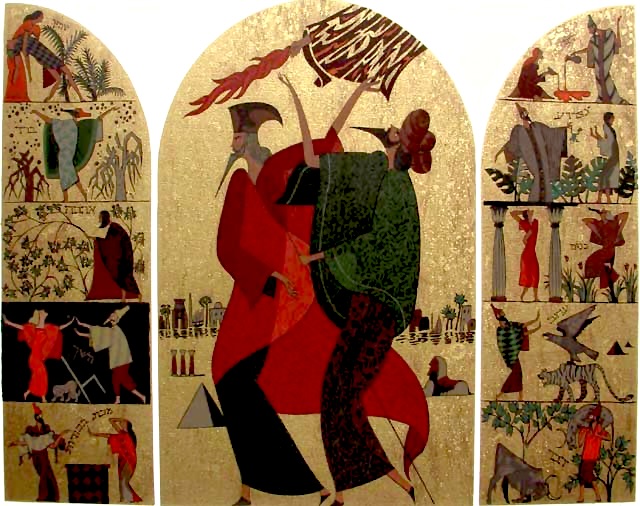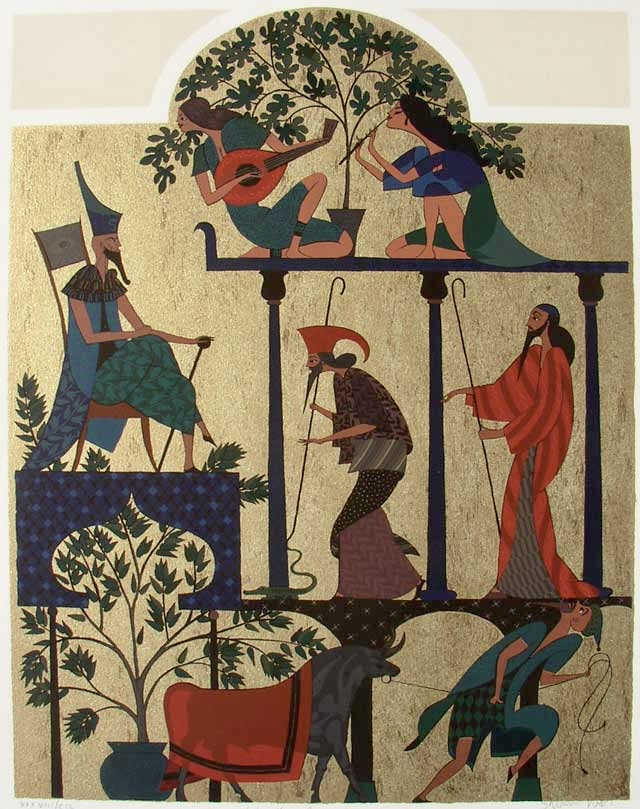Torah Study Date
Saturday, June 3, 2023
Verses Covered
Exodus (Sh’mot) 7:16-7:29
Next Session
Saturday, June 10, 2023
Starting at Exodus 8:1
Last week we discussed why YHVH tells Moses to station himself by the Nile in the morning and R. Sara said it is because Ra is the Sun God and would be at the height of his power in the morning (so that a defeat of him would be even more impressive). Then we discussed Moses telling Pharaoh to let the Israelite people go but Pharaoh not listening. Some discussion ensued about the idea of not listening, heeding, or hearing.
Then we discussed the first plague, the plague of blood. Moses tells Pharaoh that he will stretch his rod over the Nile, that it will turn to blood, that the fish will die and stink, and that at that point the water will be undrinkable. YHVH then tells Aaron to hold his rod over all the Egyptian bodies of water—the rivers, canals, and ponds—so that there is blood in all of Egypt, in the bodies of water, and even in the wood and stone. We discussed finding blood everywhere, even in wood or stone, which might seem invulnerable. R. Sara suggested the blood might be an algal bloom (as in algae). Aaron did as commanded and all the Egyptian waters turned to blood, the fish died and stank, the water became undrinkable, and there was blood throughout all of Egypt.
But then the Egyptian sorcerers did the same with their spells and Pharaoh’s heart was strengthened. We discussed the idea that Pharaoh most likely did not think the blood came from a competing god, YHVH, but that what happened was just a sorcerer’s trick. We discussed Pharaoh’s heart strengthening (often translated as ‘hardening’) just as YHVH had predicted. We discussed the rabbinic idea that YHVH did not start hardening Pharaoh’s heart until the sixth plague but R. Sara pointed out that the Hebrew would admit the idea that he had started hardening it all along (the rabbis wanting to soften the story too much). We noted Pharoah going into his house and not setting his heart even on this (meaning, was not concerned even about there being blood throughout all of Egypt). Meanwhile, while Pharoah just went into his house, the Egyptians were digging all around the Nile to find some water that was still drinkable. We noted that simply going into your house when there is a crisis is a pretty good figure for the powerful, who can protect themselves and let others figure out how to deal with problems.
Seven days later, Moses tells Pharoah to let the people go and that, if he does not do that, YHVH will plague all of Egypt with frogs. We noted how creepy the whole idea is: the frogs will swarm the Nile, enter Pharoah’s house, bedroom, and bed (so much for Pharaoh just escaping into his house), enter all the other houses (Pharoah’s servants’ houses and the people’s houses), and into Pharaoh’s ovens and kneading bowls; they will come up on Pharaoh, his people, and his servants.
Some other topics we touched on were: that none of the Egyptians have rods anymore (note the indirect reference to losing manhood), that many of the plagues are natural occurrences, and that maybe frogs were gods to Egyptians (a topic to be clarified and pursued further next time).
Our artwork this week is by Jewish Polish-Israeli artist, Shlomo Katz (1937-1992), The Ten Plagues (above), and Let My People Go (below). Each of them is a metallic ink serigraph. They are from Katz’s Passover Portfolio. The metallic ink serigraphs were a later development from a technique he created earlier of oil painting on gilded surfaces.
Katz was born in Lodz, Poland, but moved with his family to Palestine in 1945 when he was eight. He studied art at the Aviv Institute in Tel Aviv and at the École des Beaux-Arts in Paris. The Ten Plagues illustrates each of the plagues, starting with blood (dam) at the top right. Let My People Go shows Moses and Aaron, with their staffs, beseeching Pharoah to let the Israelites go. If you look closely, you’ll see Moses’ staff turning into a little alligator.


